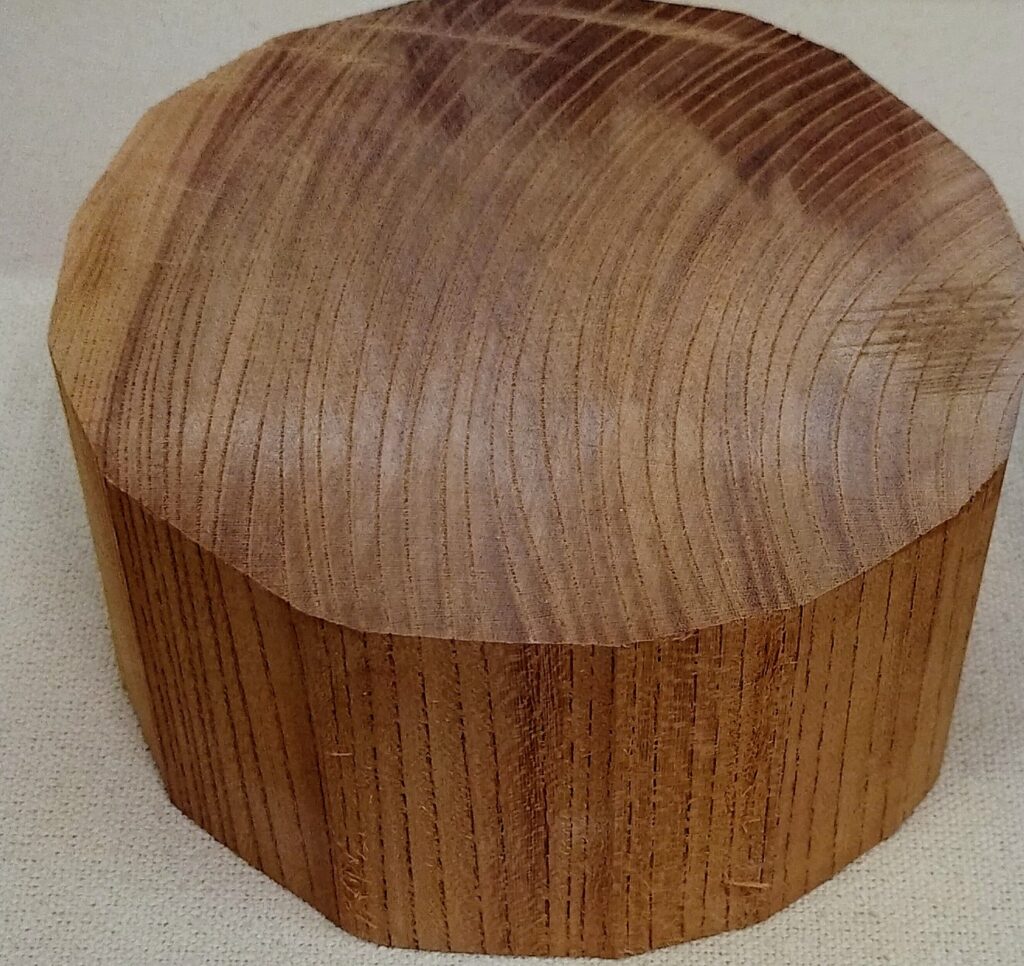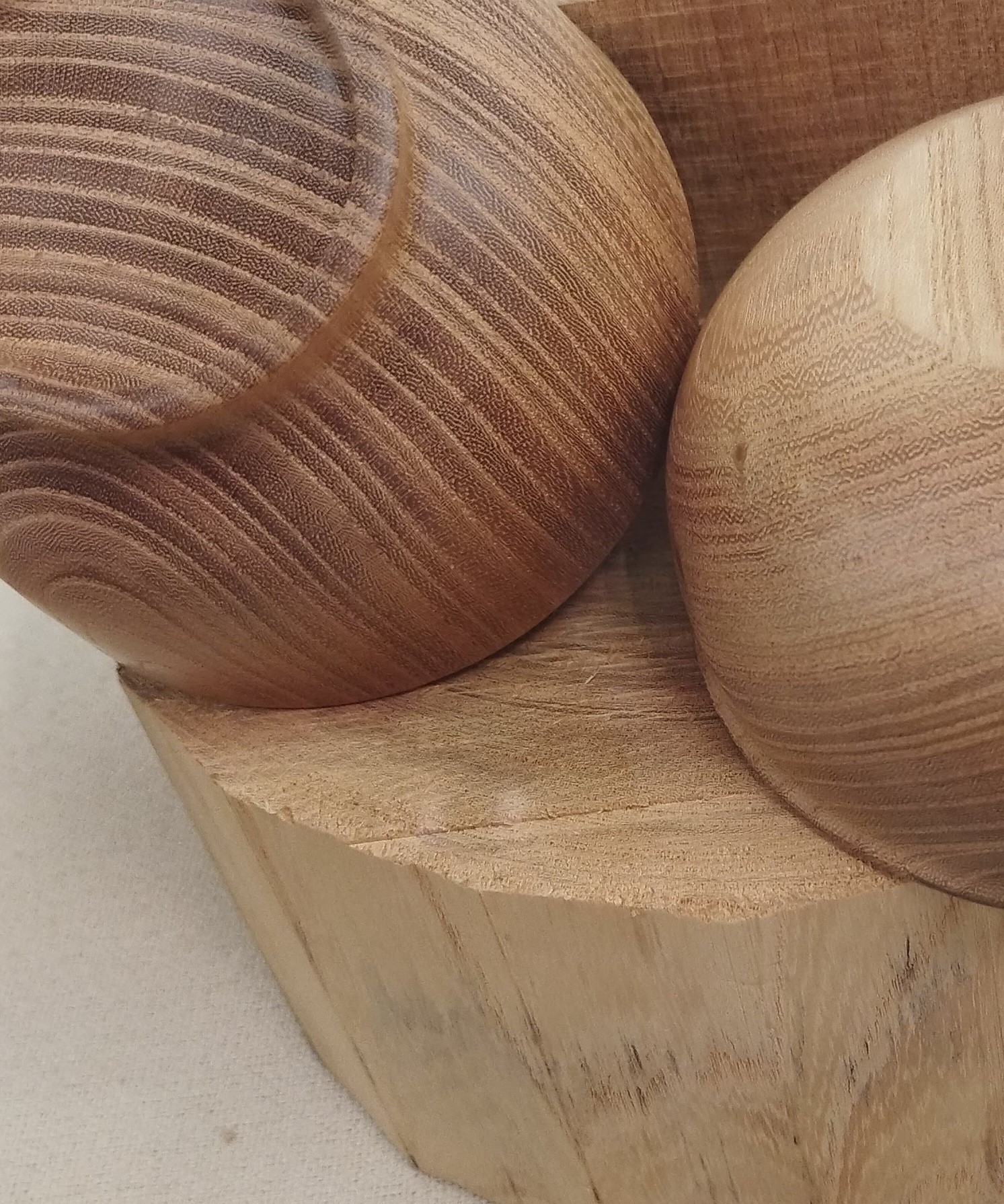本ブログではインバウンド(訪日外国人)ビジネスだけでなく企業接待や留学生対応等で英語説明が必要ながら多忙で情報収集に中々時間をかけられない方々の為にすぐに使える情報をわかりやすく解説しています。
今回はビジネス商談の為、週末を挟んで訪日中の重要顧客から、以前より興味のあった日本伝統工芸品の作業工房に「週末行ってみたい」と言われ、取り急ぎ、数ある工芸品の中から《山中漆器》工房にご案内をすることになったシチュエーションです。
今回テーマは工房案内の際の職人の作業に係る簡単な口頭説明とQAがメインですので、高度な知識や詳細情報をご希望の場合は公式サイトや専門家ブログ等をご参照下さい。《山中漆器》には大きく分けると『木製漆器』と『近代漆器』の2種ありますが、それぞれの各工程を実際に一緒に見ている想定で説明例を置きました。
👉補足:本ブログでは《山中漆器》テーマを下記2タイプ(1.商品説明表現用 / 2.工房案内表現用)揃えています。『演習ツール』『Glossary!用語集』は音声サンプルで発音練習ができます。ご興味に合わせてリンクよりお試しください。本編は下記★印となります。
- :山中漆器:英語説明表現
- 山中漆器:工房案内表現(★本編です。)
0.a 工房見学前の事前説明について(ご参考)
今回テーマではありませんので、具体的な工房見学に入る前にお相手に最低限お伝えした方が良いと思われる点をご参考までにご紹介します。今回は「工芸品」イコール「陶磁器」と思っておられる(陶器、磁器、漆器の区別が不明瞭な)多くのインバウンドを想定して置きましたが、何事もお相手の知識、ご経験、好みによりますので、状況に合わせて適当に選択、修正してお試しください。👉よりご理解いただき易いように、関心の高い「食」「日本人」も織り込んでみました。
《日本語》
- 日本の伝統工芸品の食器は大きく分けて陶磁器と漆器に分けられます。
- 大きな違いは、陶磁器は粘土を整形して作りますが、漆器は木を削って作ります。
- 前者は固く熱に強いですが落とすと壊れやすい一方、後者はその逆の性質を持ちます。
- 和食は両者の特徴に合わせて、料理に合わせて使い分けられます。
- 一般的に、漆器は汁物、煮物のお椀や、料理皿を置くトレーによく使われています。
- 漆器は木で形を作る工程、漆で強度を出す工程、蒔絵で装飾する工程の3工程に分かれています。
- 漆器の多くは数百年前から日本各地で作られていて、競争力を高めるため、各工程の分業化と専門化が進みました。
- 山中漆器は木の工程でコスト、品質面で優位性があり、木地の生産量は日本でトップクラスです。
- 歴史的に政府に頼らず、先進性の気風もあり、木の伝統素材に加え、プラスチックの現代素材も取り入れています。
- 山中漆器では木の伝統素材の作業工程と現代素材の作業工程の2種の見学ができます。
《英訳例》
- Traditional Japanese tableware can be broadly divided into two categories: ceramics and lacquerware.
- The main difference is that ceramics are made by shaping clay, while lacquerware is made by shaving wood.
- The former is hard and heat-resistant but fragile when dropped, while the latter has the opposite characteristics.
- Japanese cuisine is adapted to the characteristics of both, and they are used in different ways to suit different dishes.
- In general, lacquerware is often used for soup and stew bowls and for trays on which food plates are placed.
- Lacquerware is made in three processes: shaping with wood, strengthening with lacquer, and decorating with maki-e (gold-relief lacquering).
- Most lacquerware has been made in various parts of Japan for hundreds of years, and in order to increase competitiveness, each process has been divided and specialized.
- Yamanaka Lacquerware has an advantage in cost and quality in the wood process, and is one of the top producers of wood base in Japan.
- Historically, the artisans has not relied on the government and has a spirit of forward-thinking, and in addition to traditional materials made of wood, it also incorporates modern materials made of plastic.
- At Yamanaka Lacquer Ware, you can see two types of work processes, one for traditional wooden materials and the other for modern materials.
0.b 今回説明工程(概要)
木製漆器(前書き)
- 木地挽き♦Grain Mill
- 木地固め♦hardening of the wood
- 塗り♦Lacquering
- 蒔絵♦Maki-e
近代漆器(前書き)
- 成形♦Molding
- 塗装♦Painting
- 蒔絵♦Makie
1.木製漆器(作業工程)
伝統的な木地ベースの工房見学をするパターンです。実際に一緒に目の前の作業を見ているので、こんなに細かい説明をする必要は勿論ありませんが、一通りの表現が念頭にあれば、相手の反応に合わせて臨機応変な対応が(特に「何故?」=作業意図=の説明はロジカルなインバウンドにはとても重要なので)できますので、下記のレベルで置いています。👉いつも通り、日本語で言えないことは英語でも言えませんので、日英の順で。
1-1.木地挽き
ここは、動きが目でわかる木挽き工程なので、9ステップに分けています。
- 一本の木から出来るだけ、多くの器を作る為、まず丸太の木を輪切りします。
- その輪切りにされた木片から、作りたい器の大きさの木片を切り出します。
- その木片は強度を出す為、木目模様が器の縦方向に走るように切り出されます。
- 👉山中漆器の特徴の「縦木取り(たてきどり)」ですが、ここではその意図だけ説明しています。山中漆器の特徴と言いたい時は、簡単に’In Yamanaka lacquerware’と添える手もあります。
- ろくろ挽きで目標の器の少し大きめの形状まで整えてから、自然乾燥の為、暫く寝かせます。
- 乾燥期間が短いと歪みが出るため、約3か月は必要と言われています。
- 木が安定した状態になって、外側、内側の順番に削り、木地として完成させます。
- 木を削る際には、装飾の為、表面に円状や渦状の模様をつけることもあります。
- 👉山中漆器の特徴の「加飾挽き(かしょくびき)」ですが、ここも作業意図だけ説明しています。
- 木を削る為のカンナは、多様な作業ができる様に多くの種類があります。
- 完成度を高める為、職人はそのカンナを自ら作り、自らの手のように使いこなします。

《英訳例》
- In order to make as many vessels as possible from a single piece of wood, the log is first cut into round slices.
- From these slices, pieces of wood the size of the vessel to be made are cut.
- The pieces of wood are cut in such a way that the grain pattern runs lengthwise on the vessel in order to give it strength.
- After the wood is shaped to a slightly larger size, it is left to dry naturally for a while.
- If the drying period is too short, distortion will occur, so it is said that about three months is necessary.
- When the wood becomes stable, it is shaved on the outside and the inside in this order to complete it as a wooden base.
- When shaving the wood, a circular or swirling pattern is sometimes added to the surface for decoration.
- There are many types of planers used to sharpen wood for a wide variety of work.
- In order to enhance the degree of perfection, the craftsman makes his own planer and uses it as if it were his own hand.
1-2.木地固め
ここは強度を高める為の目に見える変化が少ない工程なので、4ステップで置きました。
《日本語》
- 変形を防ぐため、木地の木目に漆を染み込ませます。
- 傷みやすい縁の部分には補強の為、糊漆で布を張ります。
- 乾燥後、表面を平らにするために刃物やサンドペーパーを使います。
- 表面を滑らかにする為に、糊漆と欅(ケヤキ)の粉のパテで埋める作業を繰り返します。
《英訳例》
- To prevent deformation, lacquer is soaked into the grain of the wood.
- The vulnerable edges are covered with cloth using glue lacquer to reinforce them.
- After drying, a blade or sandpaper is used to flatten the surface.
- To smooth the surface, the process of filling in with glue lacquer and zelkova powder putty is repeated.
1-3.塗り
ここも目に見える変化が少ない工程なので、4ステップで置きました。
《日本語》
- ここでは、次の上塗りを奇麗に仕上げる為、漆を刷毛で薄く塗り重ね、表面を平らにします。
- 山中塗では、次の蒔絵工程の為でなく、油入りの漆だけで完了させる技法がよく使われます。
- 👉ここは変化をつける為、山中塗の「塗立(ぬりたて)」手法として説明してみましたが、他でも見られる手法なので、勿論’In lacquerware’だけでも良いです。
- その技法により、木目がそのままデザインとして楽しむことができます。
- 漆塗終了後は、均等に硬化させるため、自動回転する密閉棚に入れます。
- 👉ここも「風呂棚」の表現は避けて、意図だけにしています。
《英訳例》
- Here, a thin layer of lacquer is applied with a brush to flatten the surface in order to finish the next top coat process beautifully.
- In Yamanaka lacquerware, the technique of using only oiled lacquer to complete the process is often used instead of applying the next coat of Maki-e.
- This technique allows the grain of the wood to be enjoyed as it is in the design.
- After the lacquering is completed, the lacquer is placed in an airtight rack that rotates automatically to allow it to harden evenly.
1-4.蒔絵
今や海外でも通じる’Makie’ですが、ここも変化が少ない工程なので、4ステップで置きました。
《日本語》
- 下地(漆を塗った木地)に漆で文様や文字などを描きます。
- 固まらないうちに金や銀の色粉を蒔いて、表面に定着させます。
- その後、漆で塗り固めて丁寧に磨き上げ、蒔絵と呼ばれる装飾が完成します。
- 山中塗ではその文様や文字が浮き上がり立体感を見せる技法も使われます。
- 👉ここも「高蒔絵」の呼称は使わない例です。
《英訳例》
- A pattern or character is drawn with lacquer on the base (lacquered wood).
- Before it hardens, colored gold or silver powder is sprinkled on the surface to fix it in place.
- The lacquer is then hardened and carefully polished to complete the decoration called maki-e.
- In Yamanaka-nuri, a technique is also used to make the patterns and characters float and show a three-dimensional effect.
2.近代漆器(作業工程)
山中漆器の大きなビジネス上の特徴とも言える近代漆器の工房見学をするパターンです。実際にこの工程見学はビジネス目的のインバウンドに限られると思いますが、伝統漆器との対比(違い)を理解することは、伝統漆器自体の説明にも有用ですので、ご興味に合わせて、使えそうなところあれば、現場でもお試しください。
2-1.成形
ここも職人さんの動きを見れる部分は限られていますので4ステップです。
《日本語》
- 山中漆器では現代の多様なニーズに応えるためプラスティック素材を導入しています。
- 他の量産品工程と同じく、まず器の金型を作りその金型で樹脂を成型します。
- 金型設計で器の形状が決まりますので職人はこの工程で試作を重ねます。
- 高温の整形作業工程で不純物が除去され品質検査後、次の塗装工程へ移ります。
《英語》
- Yamanaka Lacquerware has introduced plastic materials to meet the diverse needs of today.
- As in other mass-production processes, a mold is first made for the vessel, and the resin is molded in the mold.
- The shape of the vessel is determined by the design of the mold, so the craftsmen make many prototypes in this process.
- After impurities are removed in a high-temperature shaping process and quality inspections, the vessel moves to the next step,the painting process.
2-2.塗装
ここは間近に見れる工程ではないので背景説明含め5ステップで置きました。
《日本語》
- 完成した成形品にさまざまな色で塗装されます。
- 多種多様な色が開発され、伝統漆器に近い木製感覚のある製品もできています。
- まずは成形された器に化学塗料をエアスプレーで塗布します。
- その後、約100度で30~60分ほど、熱風乾燥をします。
- 最後に、塗り職人の手作業による塗装で完成されます。
《英語》
- The finished molded product is painted in a variety of colors.
- A wide variety of colors have been developed, and products with a wooden feel similar to traditional lacquerware have been produced.
- First, chemical paints are applied to the molded vessels by air spray.
- After that, the paints are dried with hot air at about 100 degrees Celsius for 30-60 minutes.
- Finally, the painting process is completed by hand by a lacquer craftsman.
2-3.蒔絵
ここも動きが少ないため、背景説明も交え5ステップとしました。
《日本語》
- この工程では、塗装された商品に印刷技術で蒔絵を加えます。
- 器の目的や用途に応じた多様なデザインで仕上げられます。
- 基本的には、シルクスクリーン印刷がベースになります。
- 更に、手作業による従来の蒔絵の技法も使われています。
- 金銀粉を用いて色のグラデーションや立体感を出す表現も可能です。
《英語》
- In this process, maki-e is added to the painted product using printing techniques.
- The product is finished with various designs according to the purpose and use of the vessel.
- Basically, silk screen printing is used as a base.
- In addition, the traditional maki-e technique by hand is also used.
- It is also possible to create color gradation and a three-dimensional effect using gold and silver powders.
御礼🔶あとがき
お忙しい中、今回も最後までご覧いただき大変ありがとうございました。今回テーマ含め今後も定期的にブラッシュアップして参りますので、引き続きご参照のほど宜しくお願い致します。🔶Gold


